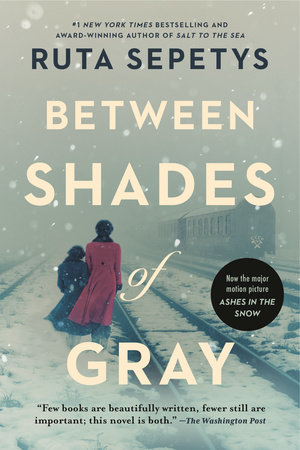TEACHING GUIDE
NOTE TO TEACHERSPlease click on the PDF link at the bottom of this page to download the Teacher’s Guide.
DISCUSSION QUESTIONS
**Correlates to Common Core Standard Reading Literature: Speaking and Listening: Comprehension and Collaboration S.L. 7.1., S.L. 8.1., S.L. 9-10.1., S.L. 7.2., S.L. 8.2., S.L. 9-10.2., S.L. 7.3., S.L. 8.3., S.L. 9-10.3. Writing: Text Types and Purposes W. 7.1., W. 8.1., W. 9-10.1., W. 7.2. W. 8.2., W. 9-10.2., W. 7.3, W. 8.3, W. 9-10.3.
1. When Jonas observes his mother smashing her beloved china and crystal before they depart their home, he asks her why she is destroying these items, and she replies, “Because I love them so much” (pg. 18). Do you consider this an act of rebellion? In your opinion, is her reaction appropriate? How might this be seen as an attempt to control the situation?
2. Using textual examples, what are some of the specific ways the deportees fight back against the NKVD? To what extent are these acts of resistance effective?
3. Being held prisoner brings out the best and worst in some of the deportees. Consider and discuss some of the ways that individuals extend their assistance and support on the deportation trains, in the Altai kolkhoz, and in the Tromfimovsk camp. How do these conditions qualify their actions—in other words, how does the context justify or not justify their actions?
4. Compare the way in which Lina tells the story to how it unfolds through the actions and words of some of the other characters—Elena, Andrius, Jonas, the bald man, even Nikolai Kretzky. How might the story be different for these narrators. What feelings does Lina’s candor evoke in you?
5. How does Sepetys use the embedded flashbacks to help readers understand why Lina’s family has been rounded up for punishment? Do you agree with their choices? Why or why not?
6. Upon arriving at the country train depot, the NKVD officers begin sorting the prisoners, and Lina asks, “Have you ever wondered what a human life is worth? That morning, my brother’s was worth a pocket watch” (pg. 35). To what extent do you interpret this as a turning point in the story?
7. Throughout the novel, Lina uses her passion for her art to remain connected to her family and the outside world. What are some of the specific ways she does this? Do you think this is a form of resistance to Stalinism?
8. Consider the consequences of not signing the documents that charge the prisoners of counterrevolutionary activities against the USSR. Do Lina’s family and the others who refuse to “confess” make the right decision? Why or why not?
9. Though Lina believes that Andrius and his mother are supplying information to the NKVD officers in exchange for food and shelter, she eventually learns that the arrangement comes at a far greater cost to his family. How does this knowledge of the lengths Andrius’ mother goes to in order to keep him safe ultimately affect him? How does Lina’s understanding of these sacrifices reshape her perception of him? His mother? Her mother? The circumstances of the camps and the prisoners?
RESEARCH TO BUILD AND PRESENT KNOWLEDGE
Correlates to Common Core Standard Literacy in History/Social Studies: Key Ideas and Details R.H. 6-8.1., 6-8.2., 6-8.3., R.H. 9-10.1., 9-10.2., 9-10.3. Research to Build and Present Knowledge W. 7.7., W. 8.7., W. 9-10.7.
Communist regimes by design rely very heavily on scientific approaches and statistical analysis in economic, demographic, and state administration. In mathematics and science classes, investigate and utilize some of the data from the Soviet era for concept and skills application. Examples might include data related to changes in literacy rates, economic outputs (particularly in heavy industry, consumer goods, and agriculture), demographics and population shifts, technology development, transportation and communications development, climate/meteorology/geology in Siberia, and data related to the USSR in World War II. As much as possible, encourage students to relate these applications to events in the novel.
CREATIVE CONNECTIONS
Investigate the style and works of Edvard Munch. The Norwegian symbolist/expressionist was the creative inspiration for Lina’s future aspirations before deportation, and is her touchstone to intellectual sanity after it. Encourage students to not only explore why Munch’s work was distinctive within the movements he is associated with, but why his work might have served as inspiration for Lina in both freedom and captivity

